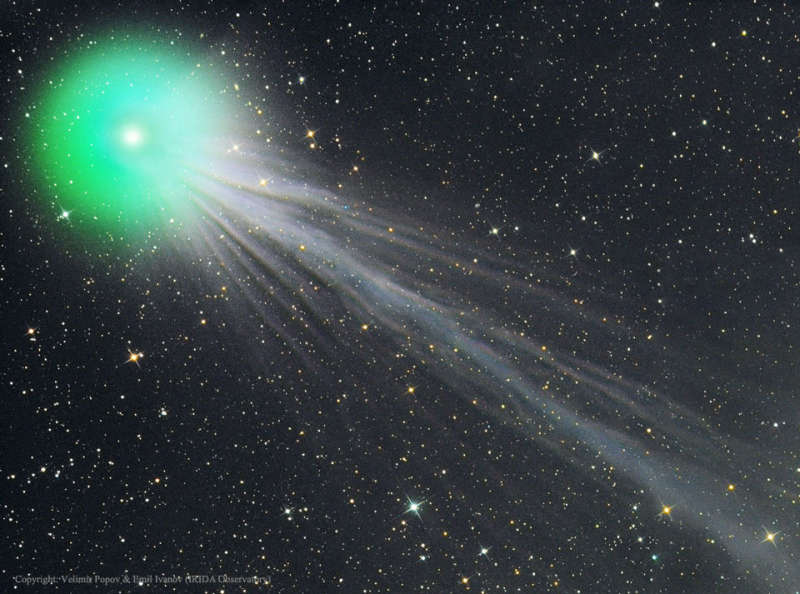Credit & Copyright: Velimir Popov & Emil Ivanov
(IRIDA Observatory)
Explanation:
What causes the structure in Comet Lovejoy's tail?
Comet C/2014 Q2 (Lovejoy),
which is currently at naked-eye brightness and
near its brightest,
has been showing an exquisitely detailed ion tail.
As the name implies, the
ion tail is made of
ionized gas -- gas energized
by
ultraviolet
light
from the Sun and pushed outward by the
solar wind.
The solar wind is quite structured and sculpted by the Sun's complex and ever
changing magnetic field.
The effect of the variable solar wind combined with different gas jets venting from
the comet's nucleus accounts for the tail's complex structure.
Following the wind, structure in Comet Lovejoy's
tail can be seen to move outward from the
Sun even alter its wavy appearance over time.
The blue color of the ion tail is dominated by recombining
carbon monoxide molecules,
while the green color of the coma surrounding the head of the comet is created mostly
by a slight amount of recombining
diatomic carbon
molecules.
The featured three-panel mosaic image was taken nine days ago from the
IRIDA Observatory
in
Bulgaria.
Comet Lovejoy made it closest pass to the Earth two weeks ago and will be at its
closest to the Sun in about ten days.
After that, the
comet will fade as it heads back into the
outer Solar System, to return only in about 8,000 years.
Astrophysicists:
Browse 950+ codes in the Astrophysics Source Code Library
1999 2000 2001 2002 2003 2004 2005 2006 2007 2008 2009 2010 2011 2012 2013 2014 2015 2016 2017 2018 2019 2020 2021 2022 2023 2024 2025 |
Январь Февраль Март Апрель Май Июнь Июль Август Сентябрь Октябрь Ноябрь Декабрь |
NASA Web Site Statements, Warnings, and Disclaimers
NASA Official: Jay Norris. Specific rights apply.
A service of: LHEA at NASA / GSFC
& Michigan Tech. U.
|
Публикации с ключевыми словами:
comet - comet tail - кометные хвосты - кометы
Публикации со словами: comet - comet tail - кометные хвосты - кометы | |
См. также:
Все публикации на ту же тему >> | |
